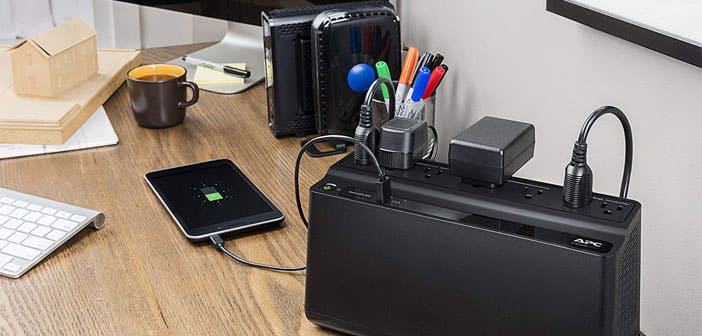The UPS protects the electrical devices from power surges and keeps them on and running for a while to continue the activities in progress or switch off the total safety devices.
It happens to everyone to experience a power surge or a real blackout while working on the PC and losing precious data before saving them. Unfortunately, this possibility can happen in many situations more frequently than you think.
For example, a blackout blocks operations and erases the last data’s memory not yet saved, blocking access to routers and ADSL. In addition to interrupting activities in progress, we have to deal with the damage that sudden voltage changes can cause to the various devices.
To make this eventuality not happen, the first thing to do is have a UPS, also called UPS, which stands for Uninterruptible Power Supply. The UPS becomes essential for protecting the PC above all electronic devices connected to the electrical outlet, home, or office. The type of uninterruptible power supply we will be dealing with is addressed to home or office use.
Table of Contents
How to choose a continuity group: Types and Characteristics
Starting from the idea that by purchasing a UPS, we are entrusting our hardware’s security to an incomparable instrument in its function. We must be sure that the product we choose corresponds perfectly to the characteristics we seek.
Using an unsuitable model, we could obtain the opposite effect, i.e., that the UPS does not support the connected devices during power surges and can damage devices, memories, and work. Therefore, the first important distinction is to know three types of UPS: online, line-interactive, and offline.
Let’s see the differences and the characteristics to evaluate to ensure you choose the most appropriate UPS.
Online (double-conversion)
This is the least common type in the home due to its high cost. In UPS of this type, the incoming AC from the electric network is converted into a direct current to recharge the battery.
At the same time, we have a second conversion: the continuous voltage output from the battery is transformed into alternating current to power appliances and devices in operation. When the current is missing, the trip time (the period between the absence of voltage and the UPS intervention) is practically nil.
Line-interactive
This type is the most recommended for a good quality/price ratio and is the most widespread in home or small-medium companies. In this type of UPS, the input current is filtered and regulated thanks to the AVR (Automatic Voltage Regulator, a circuit that damps the peaks and compensates for the voltage drops).
When a sudden drop in the electrical current occurs, the inverter activates the batteries, which supply the connected devices. Uninterruptible power supplies with a pure sine-wave inverter produce a flow of electricity identical to the electricity grid. The intervention time is between 5 and 10 milliseconds, enough for the equipment to remain switched on.
Offline
This is the most economical type of UPS. The input current goes directly to power the devices, even in voltage fluctuations, which are more or less serious. Meanwhile, the power supply keeps the battery charged to keep it ready in case of immediate intervention. The action time is around 10 milliseconds.
Wattage
Before purchasing a UPS, check the required wattage. The power is expressed in Watt and VA, for which we will find indications like 1500 VA / 900 Watt.
We must understand how many and which devices can be connected to this parameter. If we need to connect several devices, these must not exceed the total wattage the product indicates. This is because you will not withstand the overload from the instrumentation and will not stand up to a power surge.
High wattage is recommended for those connecting multiple servers or devices in the office, while connecting a single PC for home use could be very low wattage.
Autonomy
Another fundamental requirement is the maximum autonomy that our UPS guarantees. We can find models ranging from 5 to 30 minutes. Being powered by batteries, the device will certainly have an autonomy lower than the duration of a black-out, but it at least allows you to turn off your equipment safely.
Batteries
12V batteries power the uninterruptible power supplies. Some models may contain two to give greater autonomy to the device. It can take 4 to 8 hours to recharge the batteries.
The Best UPS for Home and Professional Use
Below is a complete list of the top 10 best UPS with relative prices and technical characteristics.
Product prices and availability are subject to change. Therefore, any price and availability information displayed on Amazon at the time of purchase will apply to purchasing any products.
